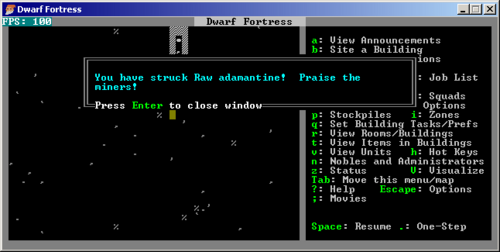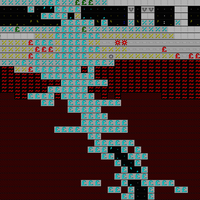- v50 information can now be added to pages in the main namespace. v0.47 information can still be found in the DF2014 namespace. See here for more details on the new versioning policy.
- Use this page to report any issues related to the migration.
Difference between revisions of "v0.31:Raw adamantine"
(Moving spoilers to bottom, so those who do not want to see can just stop reading, instead of having to skip down over them.) |
|||
| Line 43: | Line 43: | ||
One serious downside to mining veins of raw adamantine is that digging into the hollow section will eventually lead to a certain {{L|Hidden Fun Stuff|spoiler}}, triggering {{L|losing|dangerously large amounts of fun}} which can and usually will wipe out even a mature, heavily defended fortress. On the bright side, the location of all adamantine veins will be revealed at this time. | One serious downside to mining veins of raw adamantine is that digging into the hollow section will eventually lead to a certain {{L|Hidden Fun Stuff|spoiler}}, triggering {{L|losing|dangerously large amounts of fun}} which can and usually will wipe out even a mature, heavily defended fortress. On the bright side, the location of all adamantine veins will be revealed at this time. | ||
| − | Adamantine can be found in vertical pillars in the {{L|magma sea}}. This makes mining difficult, as one must either drain the area around the pillar to mine the pillar fully, or in cases of thicker pillars, mine out only the interior without breaching the exterior layer (and thus flooding the interior with magma). However, with the access to vast amounts of water almost guaranteed on any map thanks to | + | Adamantine can be found in vertical pillars in the {{L|magma sea}}. This makes mining difficult, as one must either drain the area around the pillar to mine the pillar fully, or in cases of thicker pillars, mine out only the interior without breaching the exterior layer (and thus flooding the interior with magma). However, with the access to vast amounts of water almost guaranteed on any map thanks to underground lakes, it might be possible to use selective flooding to cool the magma around the adamantine, and build walls of obsidian around them. |
Revision as of 13:50, 25 October 2010
| ||||||||||||||||||||||||||||||||||||
| Uses | ||||||||||||||||||||||||||||||||||||
|---|---|---|---|---|---|---|---|---|---|---|---|---|---|---|---|---|---|---|---|---|---|---|---|---|---|---|---|---|---|---|---|---|---|---|---|---|
|
| ||||||||||||||||||||||||||||||||||||
| Location | ||||||||||||||||||||||||||||||||||||
|
| ||||||||||||||||||||||||||||||||||||
| Properties | ||||||||||||||||||||||||||||||||||||
| ||||||||||||||||||||||||||||||||||||
| This article is about an older version of DF. |
The ore of Template:L is absurdly valuable, and can be processed into one of the most valuable Template:L in the game, both in monetary worth and utility. Its discovery is both a boon and a bane; it has a massive Template:L even unrefined, and weapons and armor made from it are very likely among the best possible. Its high melting point means you can easily use it to build magma-safe mechanisms and floodgates, but this is not recommended due to its scarcity and value in other items.
Raw adamantine has a Template:L of x250. For a comparison to other mined materials, generic Template:L has a MM of x1, Template:L x3, Template:L x 10, Template:L x30, and Template:L x40. Processed Template:L "metal" has a multiplier of x300, the highest in the game of any Template:L.
Adamantine is so valuable, both in price and usefulness, that a special message pops up when your miners discover a vein of it.
Location
Every map can contain adamantine, regardless of the location. Very small maps can lack adamantine veins, usually however multiple veins are present (~1 per 4 embark squares). If an adamantine veins is located in an embark square, it will be in the center of this square.
Storage
Raw Adamantine is stored in stone stockpiles with "Raw Adamantine" enabled in that stockpile's 'other stone' category.
However once strands are extracted, they are stored in a cloth pile. It is unfortunately impossible to directly segregate adamantine from plant fiber and silk cloth, because all cloth apparently counts as non-plant/animal products as far as the game is concerned, and adamantine does not appear as a thread/cloth type in the cloth custom stockpile menu. Furthermore, adamantine strands will never be stored in empty stockpile tiles or in empty bins - they will only be stored in existing thread bins which have not yet been filled up.v0.31.12
Veins and Mining
Raw adamantine veins, in contrast to usual ore veins, span z-levels nearly exactly straight upwards, and are thicker than many gem clusters; this and the fact that the lower half of an Adamantine vein is hollow give veins a tube-like feel. Single z-level clusters can also be found in the walls of the magma sea. Adamantine veins can span from 5 to 30-40 z-levels, sometimes even significantly more. Despite being impossibly strong, a simple copper pick works fine for mining it out, and the top half of a vein is full of raw adamantine ripe for the diggin'. Just make sure you don't dig too deep...
One serious downside to mining veins of raw adamantine is that digging into the hollow section will eventually lead to a certain Template:L, triggering Template:L which can and usually will wipe out even a mature, heavily defended fortress. On the bright side, the location of all adamantine veins will be revealed at this time.
Adamantine can be found in vertical pillars in the Template:L. This makes mining difficult, as one must either drain the area around the pillar to mine the pillar fully, or in cases of thicker pillars, mine out only the interior without breaching the exterior layer (and thus flooding the interior with magma). However, with the access to vast amounts of water almost guaranteed on any map thanks to underground lakes, it might be possible to use selective flooding to cool the magma around the adamantine, and build walls of obsidian around them.
(end spoilers)
[INORGANIC:RAW_ADAMANTINE]
[ITEM_SYMBOL:'*']
[THREAD_METAL:ADAMANTINE:100]
[STATE_NAME_ADJ:ALL_SOLID:raw adamantine]
[STATE_NAME_ADJ:LIQUID:molten raw adamantine]
[STATE_NAME_ADJ:GAS:boiling raw adamantine]
[DISPLAY_COLOR:3:7:1]
[TILE:156]
[MATERIAL_VALUE:250]
[SPEC_HEAT:7500]
[MELTING_POINT:25000]
[BOILING_POINT:50000]
[SOLID_DENSITY:200]
[LIQUID_DENSITY:2600]
[MOLAR_MASS:55845]
[IMPACT_YIELD:2500000]
[IMPACT_FRACTURE:3000000]
[IMPACT_STRAIN_AT_YIELD:0]
[COMPRESSIVE_YIELD:2500000]
[COMPRESSIVE_FRACTURE:3000000]
[COMPRESSIVE_STRAIN_AT_YIELD:0]
[TENSILE_YIELD:2500000]
[TENSILE_FRACTURE:3000000]
[TENSILE_STRAIN_AT_YIELD:0]
[TORSION_YIELD:2500000]
[TORSION_FRACTURE:3000000]
[TORSION_STRAIN_AT_YIELD:0]
[SHEAR_YIELD:2500000]
[SHEAR_FRACTURE:3000000]
[SHEAR_STRAIN_AT_YIELD:0]
[BENDING_YIELD:2500000]
[BENDING_FRACTURE:3000000]
[BENDING_STRAIN_AT_YIELD:0]
[DEEP_SPECIAL]
[MAX_EDGE:1000] no swords until you can pick mats
[ITEMS_HARD]
[IS_STONE] |
| Sedimentary | |||||
|---|---|---|---|---|---|
| Igneous |
| ||||
| Metamorphic | |||||
| Ore | |||||
| Economic | |||||
| Other |
Alunite · Anhydrite · Bauxite · Borax · Brimstone · Chromite · Cinnabar · Cobaltite · Cryolite · Graphite · Hornblende · Ilmenite · Jet · Kimberlite · Marcasite · Mica · Microcline · Olivine · Orpiment · Orthoclase · Periclase · Petrified wood · Pitchblende · Puddingstone · Pyrolusite · Realgar · Rutile · Saltpeter · Serpentine · Slade · Stibnite · Sylvite · Talc | ||||

